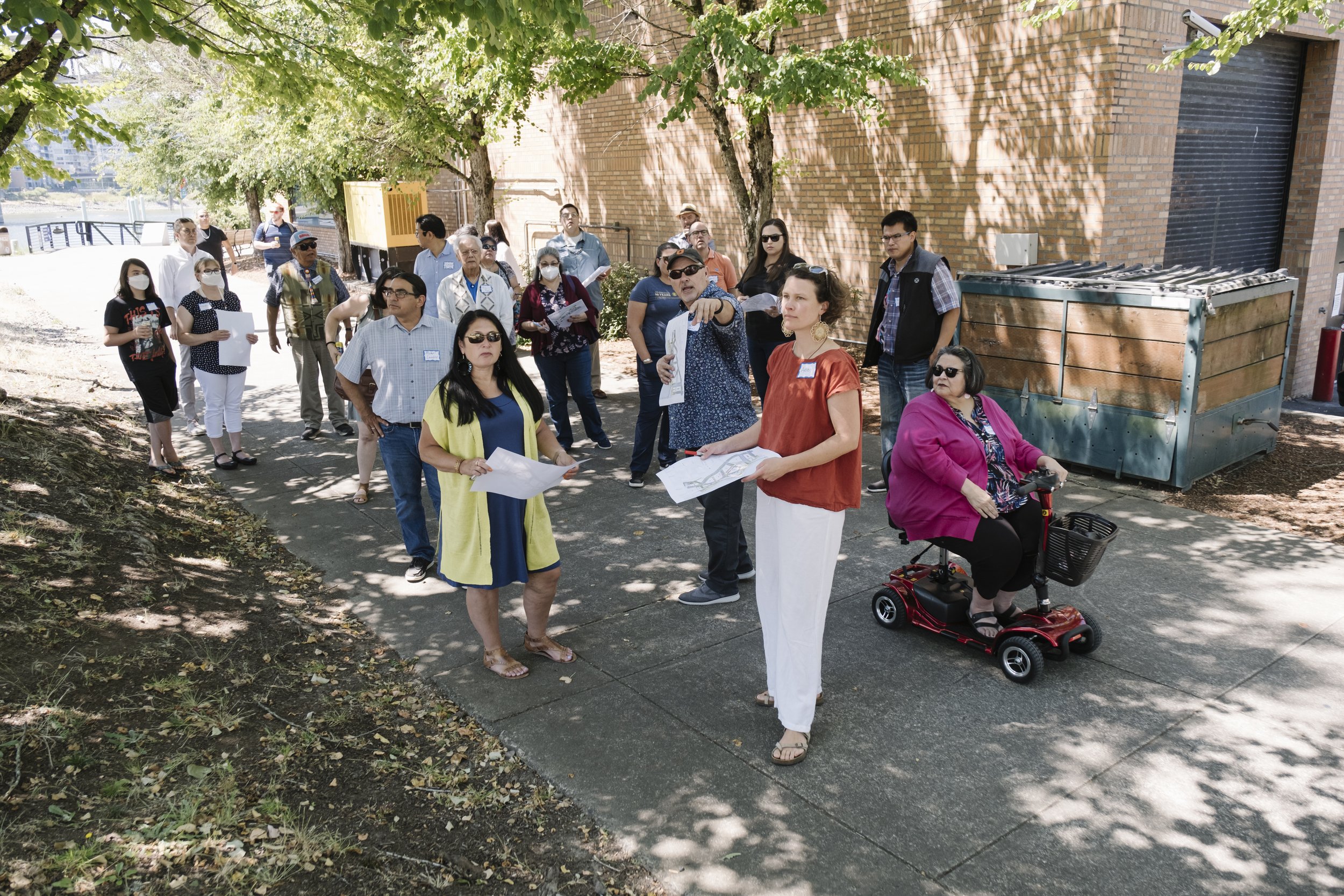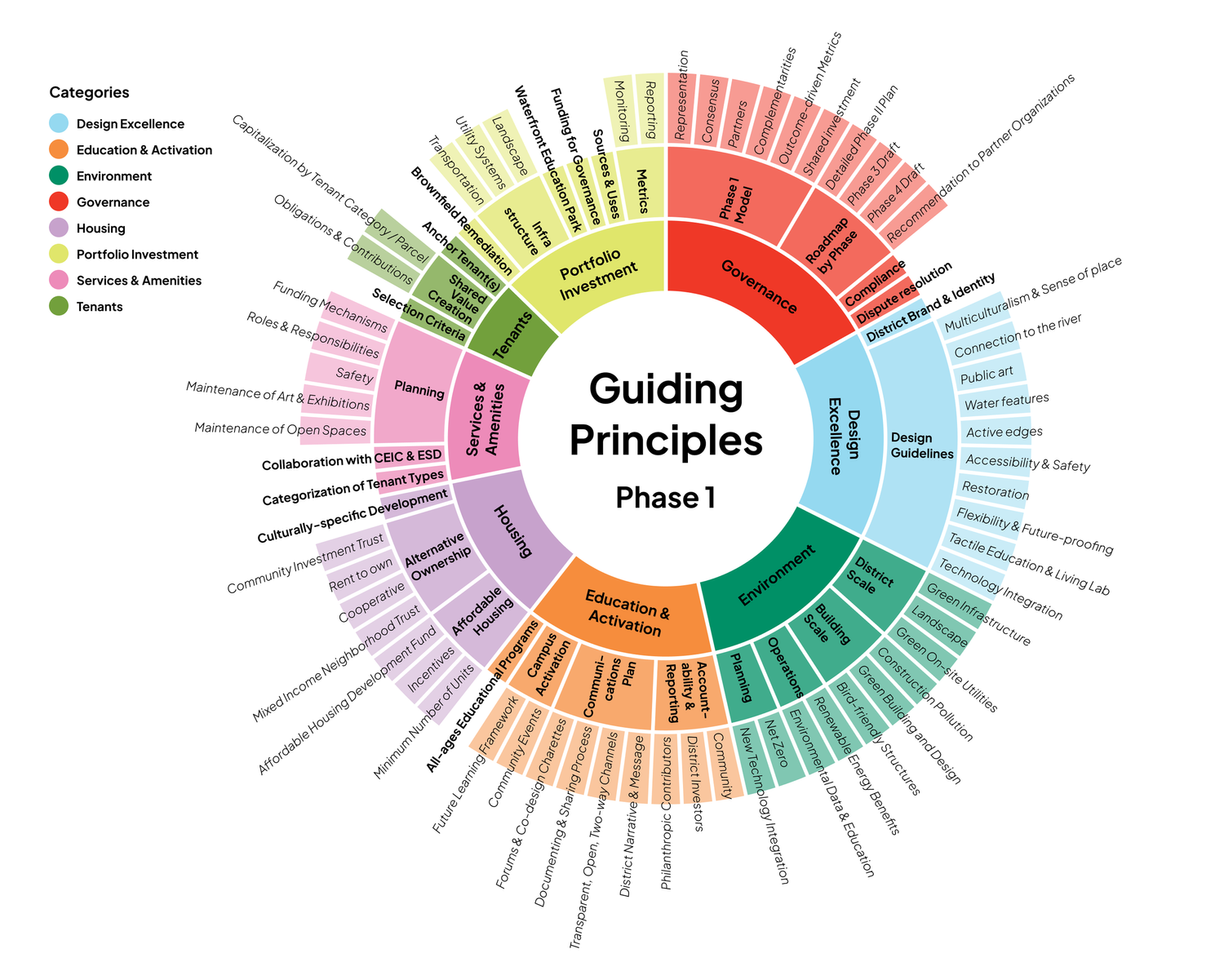
A Vision for a New District in Portland
(12 min read)
The Oregon Museum of Science & Industry (OMSI) brought Field States into its district-scale development project. Our task: to run an inclusive listening process, and surface community-driven ideas that embody OMSI’s high-level vision for equity and impact.
Our work uncovered an additional, more fundamental question:
Are Community Benefit Agreements the best way for a community’s aspirations to influence a large-scale district development process?
Together with OMSI’s leadership, we designed a new approach we call the Civic Value Framework (CVF). Purpose-built for creating shared value, the CVF foregrounds transparent shared governance, and encourages partners to create best-fit strategies at every phase of the district development process.
OMSI is a well-loved educational institution close to Portland’s heart—figuratively, and spatially. It’s a mind-expanding playground for curious people of all ages, centrally located in an industrial district at the edge of the Willamette River—and it is about to transform its neighborhood.
A science museum doing district-scale urban development is unusual, but it’s the culmination of their leadership’s unique, decades-long process to turn 24 acres of mostly asphalt into a dense and vibrant cultural hub. They defining a unique approach to redeveloping the Central Eastside industrial district, in support of an expansive vision, while honoring their commitment to leading with racial equity, dismantling systemic barriers, and engaging diverse perspectives.
Through community engagement, design explorations, and partnership, they derived a clear and succinct vision statement:
The OMSI District Master Plan is to create a one-of-a-kind neighborhood: an inclusive community destination with innovation, culture, arts, and science learning at its heart.
The new neighborhood will introduce mixed-income housing to a historically industrial area, showcase climate-tech solutions, offer indigenous cultural resources, and begin to heal the land and river—and it will enable OMSI will promote equitable opportunity far beyond educational programs.
The Central Eastside Industrial District today. Photo: OMSI
Proposal for transformation. Photo: OMSI
The OMSI District Master Plan Vision is high-level, providing compass-like direction. To draw a more detailed map, OMSI approached Field States and community engagement partner We All Rise.
1
To identify the best ideas for advancing the district vision, we designed an equity-focused co-creation and listening process to guide collaboration with the surrounding community.
2
To gather priorities, challenges, and new ideas, we planned and facilitated sessions that brought local community-based organizations together with OMSI’s staff and board. This revealed concrete ideas for realizing the vision that were aligned with community goals.
3
We synthesized all of the ideas into emerging themes, and collected insights into an actionable report.

Photo: OMSI

Photo: Field States
Our Listening Report, produced with We All Rise
Many of the ideas we heard are points typically enumerated in a Community Benefits Agreement (CBA). CBAs can do great things, but are imperfect—they only capture what can be anticipated (and negotiated!) at the outset of a 10+ year development process. Furthermore, they are fundamentally confrontational, with two sides making demands and concessions in a zero sum game.
In Portland’s recent history, CBA negotiations have unraveled several high-profile development projects—either the developer can’t accept the conditions and the coalition of community organizations opposes the project, or the project doesn’t pencil out financially and the developer walks away. Parcels languish, no one wins.
Our listening report was filled with ideas that matter to OMSI’s community, but recent history suggested that a CBA might not be the best way to ensure those ideas come to life. Together with OMSI’s leadership, we asked ourselves: can we reimagine the model itself?
💡 What is a Community Benefits Agreement?
When a large scale development project is announced, it’s common for a community-based coalition to write a list of benefit demands. The developer and coalition negotiate an agreement, with the developer offering benefits in exchange for coalition support.
CBA’s often include organized labor considerations (e.g. a requirement to hire local contractors and meet union labor standards), interest group agendas (e.g. protected bike lanes) and general urban amenities (e.g. parks and green space).
See examples from The Urban InstituteThe Civic Value Framework
We researched CBAs and development processes, led a co-design session with OMSI’s board and leadership, and followed their guidance on political dynamics and district landowner relationships.
Our work identified four main issues with the CBA model, which illuminated principles for an alternative.
Community Benefit Agreement
Civic Value Framework
Confrontational Each stakeholder is vying for their own individual agenda
Purposeful Based on values shared by developer, landowners, residents and orgs
Anticipatory The document short and long-term benefits at the very beginning of a 10+ year development process
Emergent Designed to discover, prioritize, and enact specific opportunities for civic value at every phase of the development process
Zero-sum Based on negotiated demands and concessions
Mutually beneficial Creating emergent shared value across different stakeholder groups
Outside After signing, the coalition members are outside of the project. If the developer fails to deliver benefits, the coalition must take (and pay for) legal action
Inside Coalition members actively participate in governance throughout the 10+ year process, and have a seat at the table in ongoing definition of civic value and strategies to create it
1. Civic Value in the CVF
Civic value is shared and contextual, emerging from the assets, needs, histories, and possible futures of a specific place and community. The listening report helped us more specifically define it for the OMSI district as:
The CVF states that overarching definition clearly, and binds project partners to creating value on these shared terms, at every stage of the project.
2. Building the Framework
The framework component articulates guiding principles and a governance process for creating civic value. Crucially, it spans across four project phases: Planning, Construction, Activation, Ongoing Operations and Maintenance. Each phase offers unique challenges and opportunities that only become known as the process unfolds. The CVF is designed to surface those challenges and opportunities along the way, and enable phase-specific stakeholders to arrive at consensus about how value will be created, who is responsible for creating it, and who benefits.
Practically speaking, at the beginning of each phase, a phase-specific committee (including project partners, organizations, and community members) articulates a phase-specific definition of civic value (within and contributing to the overarching project definition of civic value). Phase-specific negotiations are smaller and lower-stakes than an up-front CBA negotiation, and premised on the idea of creating shared value, not negotiating concessions. The project partners work to create civic value using capital and in-kind investments, and are held accountable by the committee and the public.
“Creating shared value is a cue for creativity. Every phase of a large-scale, multi-stakeholder development process will offer unique challenges and barriers—but also unique assets and opportunities. The best way to capture them successfully is a diverse partnership grounded in trust.”

Matthew Claudel
Founder, Field States


Guiding Principles distilled from our community engagement
SCENARIO
Using the Civic Value Framework for Increasing Workforce Diversity
In a large development project, an important opportunity for civic value is to increase the number of minorities, women, veterans, and local contractors in the labor pool (workforce diversity).
Option A:
Community Benefits Agreement
A typical CBA runs into barriers as the development project evolves.
The CBA consortium, which includes local labor organizations, decides to include a minimum percent for minority demographic representation in the labor pool in a Community Benefits Agreement. Specifically, the CBA requires every RFP the developer issues for construction contracts to include a workforce diversity minimum. The CBA lists high demographic representation percentages, as a negotiation tactic against the developer.
The specifics of the threshold are hotly contested during the negotiations. Ultimately over 10% is conceded as a tactic to win a different, higher-priority point of negotiation. The project is approved, but the developer, the CBA consortium, and the local labor organization all feel that they’ve lost, and their relationship is strained.
During the four years between CBA negotiations and contractor selection, several significant factors have changed: local labor demographics, state-level contracting regulation, the emergence of several MWESB firms, and more. The negotiated threshold is no longer a meaningful number when RFPs are issued. The developer is required to honor the initial agreement, or go through contract re-negotiations with the coalition.
The CBA negotiation is contentious, and strains the relationships between stakeholders. As the project evolves, the initial CBA becomes obsolete.
Option B:
Civic Value Framework
The CVF unlocks benefits by adapting to emerging challenges and opportunities.
Civic value is defined at a high level in the CVF. When construction begins, a phase-specific stewardship committee is convened, including the developer, a local labor organization, and two current tenants of the neighborhood. They collaboratively define what civic value can be during the construction phase.
Through a publicly accessible decision-making process, the committee includes workforce diversity as a key criterion. They organize targeted and specific negotiations between relevant parties, with the goal of defining appropriate contracting criteria to achieve demographic representation based on current information—including the project’s capital stack, grant funding, regulations, and more.
Because the committee is accountable to the public and the overarching civic value framework, its members have incentive to explore unconventional approaches to increasing workforce diversity. They creatively explore ways to remove barriers and activate latent assets.
They identify childcare as a significant barrier to workforce diversity—especially for women and low-income contractors. One of the core project partners is an early childhood educational institution that can offer deeply subsidized childcare to contractors actively working on the project. The committee formalizes an in-kind donation of childcare services in exchange for future leasing cost offsets as part of the project capital stack.
The committee has effectively created civic value through unconventional means, bringing project partners closer together as collaborators in shared value.
As of February 2023, the City of Portland’s Design Commission approved the OMSI District plan, with the CVF as a central element—a major milestone in the project. OMSI is now working closely with project partners to advance the development process. As a part of that, the CVF is currently being refined with OMSI’s indigenous partners, who have significant interest in creating shared prosperity through the OMSI District. In short, the CVF is a living document, and the principles in it are guiding partnership-based work until it becomes legally binding.
For our part, Field States is currently documenting the Civic Value Framework approach so that it can be used again in similar district-scale development projects. And we are continuously on the lookout for opportunities to design beyond existing systems (even net-positive ones like Community Benefit Agreements), to create shared value for people and places.
Outcomes
1
OMSI has stated that the principles of the CVF are continuing to guide their work with their Indigenous partners, as they make work toward creating shared prosperity through the OMSI District.
2
In May of 2023, Metro pledged (up to) $7 Million to fund the Waterfront Education Park!
Read about it here


